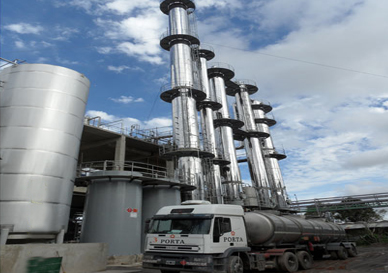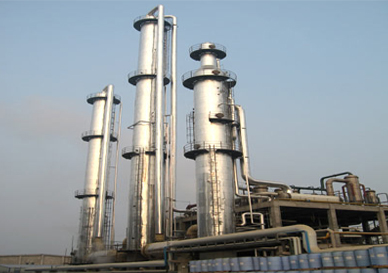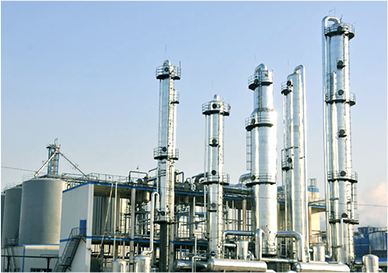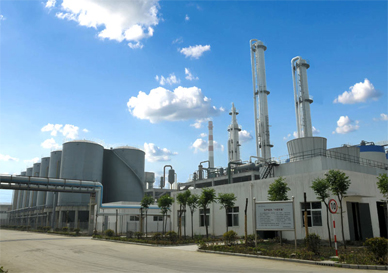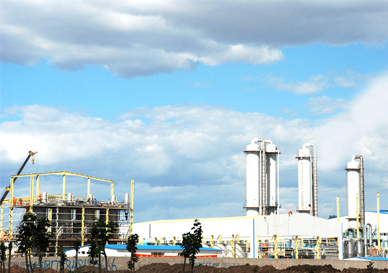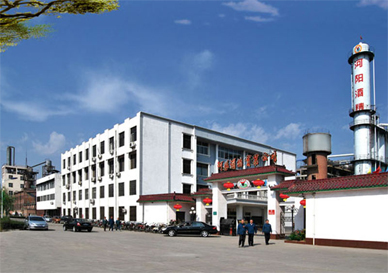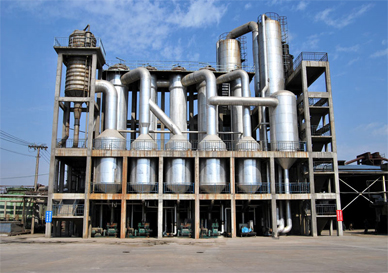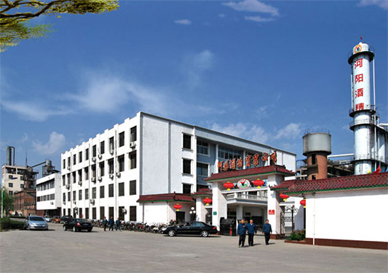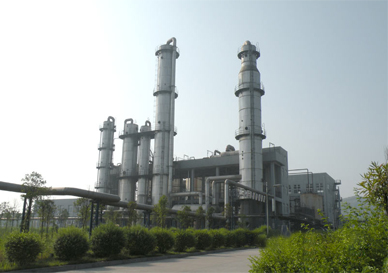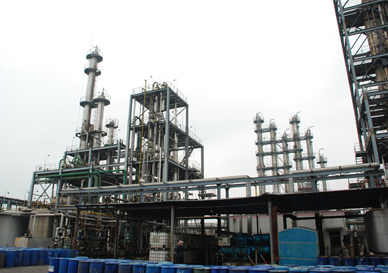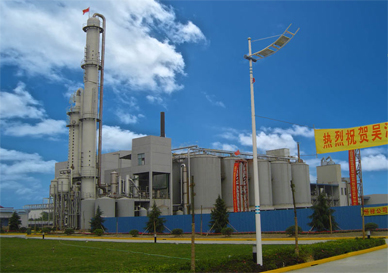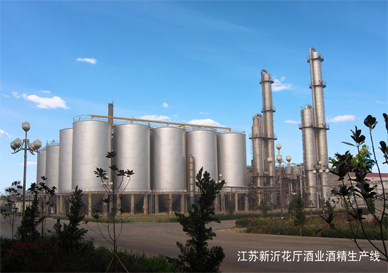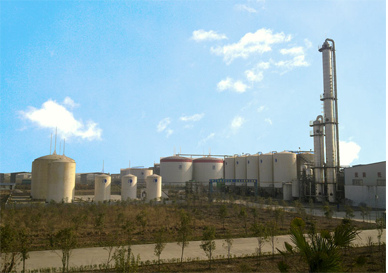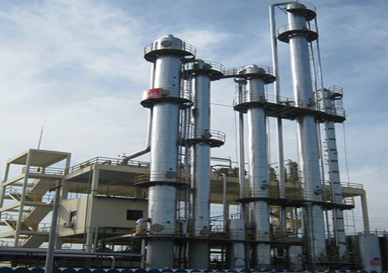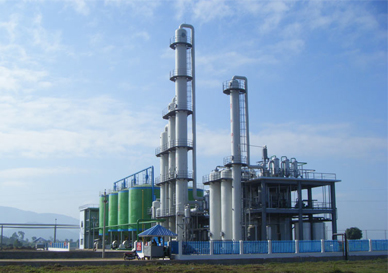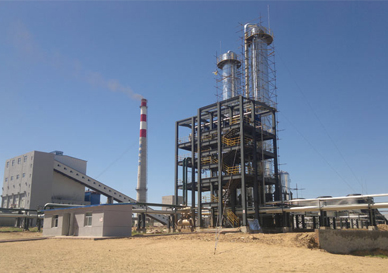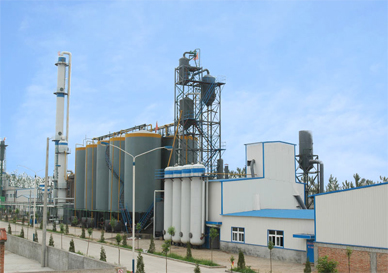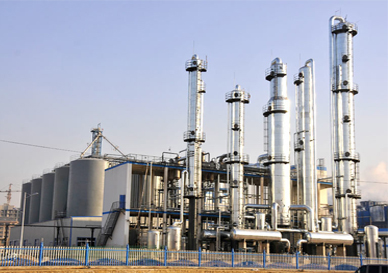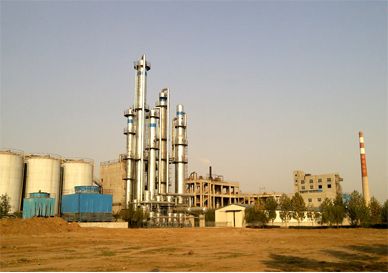Product introduction
Packed tower
Packed tower is a gas-liquid mass transfer equipment with a large number of fillers in the tower as interphase contact members. Packed towers have been applied to industrial production in the mid-19th century, and since then, it has competed with plate towers to develop, constituting two different types of gas-liquid mass transfer equipment.
The body of the packed tower is a vertical cylinder with a supporting plate at the bottom. The packing is placed on the supporting plate in a random pile or whole pile. A packing press plate is installed above the packing to limit the movement of the packing with the updraft. The liquid is added from the top of the tower, sprayed onto the filler by the liquid distributor, and flows down the surface of the filler. The gas is sent from the bottom of the tower, distributed by the gas distribution device (small diameter tower generally does not have a gas distribution device), and the liquid is countercurrent continuously through the gap of the packing layer. The gas-liquid phase is in close contact with the packing surface for mass transfer. The packed tower is a continuous contact type gas-liquid mass transfer equipment, and the two-phase composition changes continuously along the tower height. Under normal operation, the gas phase is a continuous phase and the liquid phase is a dispersed phase.
When the liquid flows down the packing layer, there is a tendency to gradually concentrate towards the tower wall, making the liquid flow near the tower wall gradually increase, this phenomenon is called wall flow, wall flow effect causes the gas-liquid phase distribution in the packing layer is not uniform, thus reducing the mass transfer efficiency. Therefore, when the packing layer is high, it needs to be segmented and the redistribution device is set in the middle. The liquid redistribution device includes two parts: a liquid collector and a liquid redistributor. The liquid flowing down the upper filler is collected by the liquid collector and sent to the liquid redistributor. After being redistributed, the liquid is sprayed to the top of the lower filler.
Packing is the core component of packing tower, it provides the gas-liquid phase contact mass transfer phase interface, is the main factor to determine the performance of packing tower. There are many kinds of fillers, which can be divided into bulk fillers and regular fillers according to the different filling methods.
1. Bulk filler
Bulk packing is a particle with a certain geometric shape and size. Generally piled in bulk in the tower, also known as pile packing or particle packing. Bulk packing can be divided into ring packing, saddle packing, ring saddle packing and spherical packing according to different structural characteristics. More typical bulk packing are: pull two ring packing, pall ring packing, step ring packing, arc saddle packing, moment saddle packing, metal ring moment saddle packing, spherical packing.
2. Structured packing
Structured packing is a kind of packing arranged in a uniform geometric pattern in the tower. The characteristic of the packing is that the gas-liquid flow path is specified, the gas-liquid distribution in the packing layer is improved, and more specific surface area can be provided at a very low pressure drop, so that the processing capacity and mass transfer performance are greatly improved.
There are many kinds of structured packing, which can be divided into grid packing, ripple packing and pulse packing according to their geometric structure.
(1) grille packing
Grid packing is composed of strip elements according to certain rules, and its structure changes with the form and combination rules of strip elements, so it has a variety of structural forms. The earliest industrial application of grille packing is wood grille packing. The more common applications are Grich grille packing, mesh grille packing, honeycomb grille packing, etc., of which Grich grille packing is the most representative. The specific surface area of the grid packing is low, so it is mainly used for occasions requiring low pressure drop, large load and anti-blocking.
(2) corrugated packing
Corrugated packing is a general type of structured packing, and most of the structured packing used in industry belongs to this category. The corrugated packing is a disc-shaped packing composed of many corrugated sheets, and the Angle of the corrugated and the tower shaft is 30. And 45. Two types, when assembled, the adjacent two corrugated plates are stacked against each other. Each tray packing is installed vertically in the tower, and the adjacent two trays of packing are staggered 90. Line up.
The advantage of corrugated packing is that it has a compact structure and a large specific surface area, and its specific surface area can be adjusted by the shape of the corrugated structure, and there are 125, 150, 250, 350, 500, 700 and so on. The adjacent two trays of packing are perpendicular to each other, so that the updraft constantly changes direction, and the falling liquid is constantly redistributed, so the mass transfer efficiency is high. The regular arrangement of the packing material reduces the flow resistance and thus improves the processing capacity. The disadvantage of corrugated filler is that it is not suitable for handling materials with large viscosity, easy polymerization or suspended matter, in addition, it is difficult to load and unload and clean up the filler, and the cost is higher.
Corrugated packing can be divided into mesh corrugated packing and plate corrugated packing according to the material structure, and its material is divided into metal, plastic and ceramic.
(3) Pulse packing
Pulse packing is a kind of regular packing which is assembled by a hollow prismatic single frame with shrinkable neck in a certain way. After the pulse packing is assembled, a porous prismatic channel with a shrinking neck will be formed, and its longitudinal channel will alternately shrink and expand, and the gas-liquid connection will produce strong turbulence. In the neck contraction section, the gas velocity is faster and the turbulence is intense, thus strengthening the mass transfer. In the expansion section, the gas velocity is reduced to a minimum to achieve the separation of the two phases. The "pulse" mass transfer process is realized by the alternating repetition of flow channel contraction and expansion.
Pulse packing is characterized by large capacity and small pressure drop, and is an ideal packing for vacuum distillation. Because of its excellent liquid distribution performance, the amplification effect is reduced, so it is especially suitable for large tower diameter occasions.
Photos of some performance:

